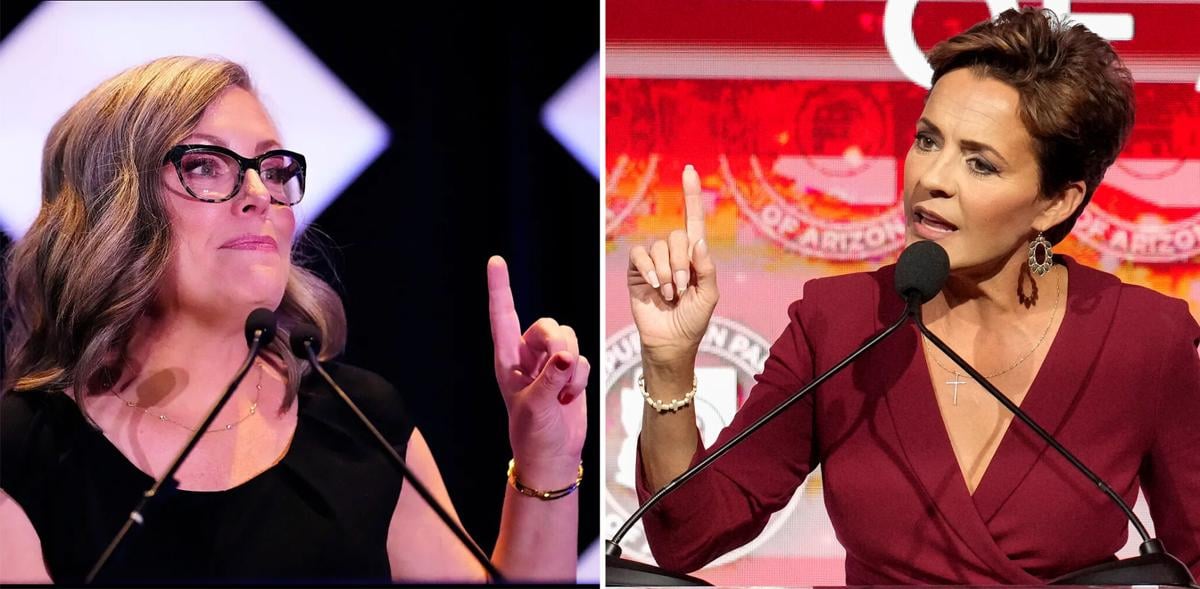PHOENIX — Gov. Katie Hobbs is asking a court to toss out Kari Lake’s latest bid to overturn the 2022 election, saying it’s based on “mere speculation of election misconduct and conjecture regarding its supposed result.’’
In an extensive filing, Abha Khanna, the Democratic governor’s lead lawyer, said the Republican contender failed to offer evidence at a trial last month that any vote was not counted. Even the ballots that on-site tabulators in Maricopa County could not read ultimately were tallied at a central location, Khanna said.
“Indeed, Lake’s witnesses could not identify a single voter who was unable to vote because of tabulator issues,’’ Khanna told the state Court of Appeals. Instead, she said, Lake relied on the speculation of pollster Richard Baris about how many people might not have cast a ballot.
In a separate legal filing, attorneys for Maricopa County rebutted Lake’s contention that problems with printers and long lines disenfranchised Election Day voters.
“One would expect that, if a full quarter of those who would have voted on Election Day had chosen not to do so — a number Baris estimated to have been as high as 50,000 voters — Lake would have been able to produce someone at trial,’’ the county’s legal brief said. “That she produced none demonstrates the unreliability of Baris’ estimate.’’
Lake is trying to get the appellate court to do what a trial judge would not last month: Install her as the governor despite the fact the final tally showed her losing to Hobbs by more than 17,000 votes; or, alternately, require a new election.
The appellate judges are set to review Lake’s arguments Feb. 1.
Printer issues
Much of Lake’s argument to the appellate judges mirrors what she presented at trial, centered around problems that occurred at some of Maricopa County’s 223 vote centers.
Unlike some counties, where people can vote only at their home precinct, vote centers allow anyone to cast a ballot at any location. That requires the center to print out a ballot on site unique to that person, with only those races on which he or she can vote.
Attorneys for the county said some of the ballots printed out were not dark enough to be read by tabulators.
Complicating matters, workers at some of the sites, seeking to resolve problems, adjusted the printers to a “fit to page’’ setting.
That resulted in a 19-inch image being printed on the 20-inch paper, which could not be read by the tabulators, programmed to accept only the larger image.
But lawyers for the county said voters were given the choice of putting the unreadable ballots into a sealed box to be counted downtown or to go to another nearby polling place. No one was denied the right to vote, they said.
Hobbs’ attorney Khanna told the appellate court that none of Lake’s witnesses provided any evidence to back her charges that the problems with the printers and tabulators were the result of “intentional misconduct,’’ citing the efforts of various technicians to fix the issue. The fact there may have been mistakes is not enough under Arizona law to set aside the results, Khanna said.
“Under Lake’s preferred standard, elections would be routinely nullified where unforeseen and unintentional technical issues occurred in some places affecting some number of voters,’’ Khanna said.
Chain of custody
Attorneys for the county also urged the appellate judges to reject Lake’s claim that “chain of custody’’ requirements were broken.
The GOP contender alleged this enabled up to 25,000 additional ballots to be added into the final batch. But the county’s lawyers detailed for the appellate judges the procedures followed for early ballots that are mailed in, those placed into dedicated drop boxes, those dropped off at polling places on Election Day and those voted in person.
“Lake did not establish that the Maricopa County defendants engaged in any misconduct regarding chain of custody documentation, let alone misconduct that would alter the results of the 2022 gubernatorial election,’’ they wrote.
Khanna also said there is no basis to believe Lake’s claim that election workers were allowing many early ballots to be counted where the signatures on the envelopes did not match what was already on file at county offices.
She did not dispute the declarations of three people who were involved at the first level of the review process who claimed they had flagged anywhere from 15% to 40% of the signatures, and that many of them ultimately were accepted. But Khanna said that’s leaving out critical facts.
Khanna said these were “first-level reviewers’’ who had access to a limited number of signatures in a voter’s registration record. Their task, she said, is to flag potential mismatches for higher-level review.
Those reviewers, Khanna said, not only had more experience than those doing the initial screening but also had access to other election documents in the voter’s registration record. She said the fact that signatures flagged at the first level ultimately were accepted shows the multi-level system works “precisely as contemplated by Maricopa’s Election Plan’s multiphase signature verification process.’’
NBC News reports that GOP-controlled Cochise County was sued by AZ Secretary of State Katie Hobbs on Nov. 28. The state's statutory deadline for certifying midterm election results fell on the same day.





